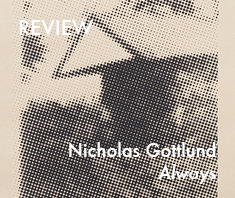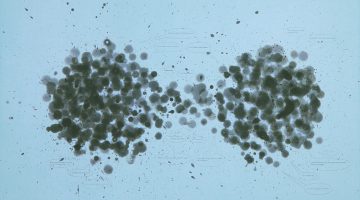Nicholas Gottlund, “Always”
Paris London Hong Kong
845 W. Washington Blvd 2R, Chicago, IL 60607
June 6–July 26, 2014
By Amanda Roscoe Mayo

Nicholas Gottlund, “Always,” 2014, installation view. Courtesy of the artist and Paris London Hong Kong, Chicago.
Nicholas Gottlund’s show, “Always,” at PLHK in Chicago is not just for print makers. His solo show certainly appeals to those with insider knowledge into the process and material, but the narrative Gottlund investigates through the work gives it legs beyond traditional print matter and technique. In the early ‘80s the artist’s family published a book entitled “Farming, Always Farming.” From this Gottlund created his own book, “Printing Always Printing,” which included cropped photos and enlarged sections from “Farming Always Farming.” The subjects are largely unidentifiable, reduced to the black dots of varying sizes characteristic of offset printing. “Always” becomes more than a solo show that delivers a body of work. Gottlund arouses the viewer’s interest in investigation and reading as a whole body experience while reminding us that the interpretation of history can become fuzzy as it is handed down through generations, even when formally recorded. The installation is an explosion of the elements of bookmaking—objects confront the audience while the story provides a narrative in which we can get lost
Knowing the method of production for these images, it becomes easy to discern that an entire page of the book has been enlarged (in fact, both books are presented on a pedestal in the center of the gallery for reference). Indicators are found in what could be considered physical traces: identifiable blurbs of illegible text beneath some of the images, a shadow from the facing page, or black space below the edge as if leftover from a poorly aligned photo copier—all reminders that the artist handled this book in order to create the work. Scale is important as the prints challenge the images found in both publications. Due to their enormous size, a reader can no longer handle these works; information may only be gleamed by looking rather than reading, seeing, and holding.

Nicholas Gottlund, “Printing Always Printing (Summer Kitchen)” 2014. Courtesy of the artist and Paris London Hong Kong, Chicago.
One has to move back and forth from the images to negotiate both a long and short view for legible understanding. Without the intimacy and flow of a book, the images have become abstracted and require distance to identify even the most familiar subject matter: agriculture, a scarecrow, a field, or portions of a building. By removing the tangible experience of holding these images in book form, Gottlund forces the viewer to investigate the material on a purely visual basis. Once up close the desire to see the image is removed and replaced with curiosity of the physical. The examination moves toward the halftone dots and how the ink is absorbed into the fibrous perforations of the archival Bristol board, to the patterns of the dots themselves, and where the negative space of the tan surface reads as physical space.

Nicholas Gottlund, “Spanner 1” 2014, installation view. Courtesy of the artist and Paris London Hong Kong, Chicago.
Hung low, a mere two feet from the ground, are long rectangular wall sculptures of aluminum wrapped in colorful fabric. These are “Spanners” and represent the colorful guides at the edge of the page used for reference in printing. Although they can’t possibly relate to the prints hung just above them (due to their colorless existence), they serve as indicators of where this project comes from: a book. These are the invisible guides, trimmed from the final product, never to be seen by anyone but those laboring to create a book. The Spanners serve a dual purpose in this exhibition—they offer a pop of color and a palate cleanser should the eyes need a rest from looking at dots, which tend to vibrate at that scale, as well as referencing the source material gesturing that this installation is something more than prints from a book. Rather than deconstructing, the artist is showing us how this work, book, and history are constructed.
What Gottlund has done with “Always” is install a life-sized book just moments before being trimmed, bound, and editioned. He has invited us in not only to a print world known to very few, but to a history that is his. It’s not just his though, is it? It’s ours, a family history, an industry that has fed this generation and many before both in food and knowledge. Rather than write another story, Gottlund has brought us inside his.

Nicholas Gottlund, “Printing Always Printing (Outhouse)” 2014. Courtesy of the artist and Paris London Hong Kong, Chicago.
For more information about the show, visit Paris London Hong Kong.
Previous contributions by Amanda Roscoe Mayo include:
Review: “Here Lies Space” group exhibition at Heaven Gallery, Chicago



